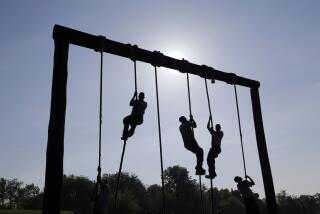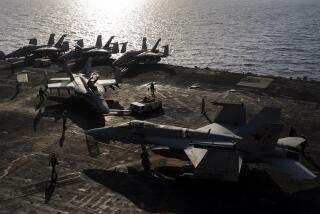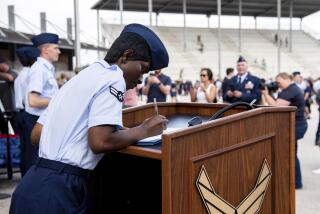Navy Will Shift Military Might to Shallower Waters
- Share via
VIRGINIA BEACH, Va. — Swift boats own a small but tortured part of Navy history. The shallow-water craft crewed by armed sailors patrolled the rivers of Vietnam, one of the most dangerous missions in the Navy.
In the 2004 presidential campaign, the boats emerged as part of a bitter debate over whether Navy veteran John F. Kerry, the skipper of one of the 50-foot vessels, was a slacker or a hero.
Now, 30 years after Swift boats were mothballed, the Navy has decided they are just what’s needed in Iraq and beyond.
Next year, the Navy will deploy a squadron of 220 sailors to patrol Iraq’s Euphrates River on 39-foot versions of the boats. Starting with a dozen vessels which can carry 16 sailors each, their goal will be to stop shipments of weapons, bombs and fighters from Syria to Baghdad.
The deployment represents a departure from the Navy’s emphasis on ships that dominate the “blue water” of the ocean and reflects a move to commit more resources to fighting insurgencies. After the Navy spent decades preparing for big wars by building aircraft carriers and nuclear submarines, its new Naval Expeditionary Combat Command is building small boats that specialize in fighting where the big ships cannot go -- harbors, coastlines and rivers, or what sailors call the “green” and “brown” water.
Rear Adm. Donald Bullard, leader of the Expeditionary Combat Command, argues that existing U.S. military capabilities have gaps that terrorists and insurgents can exploit. The Navy’s cruisers, destroyers and aircraft carriers dominate the open ocean, but are vulnerable in port. And the military for decades has not had a dedicated force for controlling coasts, rivers and delta areas.
“We are extending that maritime space. We need to be able to control the maritime environment where terrorists can operate, to deny them freedom of movement, to deny them sanctuary,” Bullard says.
In the short term, the new Navy mission is an attempt to relieve some of the weight of Iraq from the Marine Corps. Iraq has been tough on the Marines, who have been deployed to the most violent areas of Iraq and been involved in some of the war’s bloodiest battles. The Marine Corps currently operates a small number of boats on the Euphrates, which courses through contentious Anbar Province and the cities of Fallouja, Ramadi and Haditha. By taking over river patrol duties, the Navy is able to assume at least one responsibility.
The Navy wants $48 million to train its new river forces through next year. But some members of Congress have looked skeptically at the new program, suggesting the new command, created in January, duplicates other services and veers from the Navy’s traditional role.
But Navy officers are adamant the new command will offer something different. Special operations forces use small boats to silently insert and extract SEAL teams. The new Navy force wants to be anything but stealthy.
“Our forces are in the water and in the daylight,” says Capt. Michael Jordan, commander of the river force.
The mission of the new “riverine” force differs in some respects from the Swift boats of old. Swift boats at first were used only on the coastlines. But in 1968, then-Vice Adm. Elmo Zumwalt Jr., as commander of naval forces in Vietnam, changed their mission with the launch of Operation Sealords. Zumwalt began sending the boats upriver to break up guerrilla networks. The boats moved to fight insurgents close in, with intense battles the frequent result.
By contrast, the focus of the modern riverine force is supposed to be interdiction, not close combat.
“We are not building a force for major combat operations,” Jordan says. “We are trying to stop the illegal traffic, the movement of weapons and supplies.”
After the U.S. effort in Vietnam ended in failure, naval warfare scholars questioned whether the Navy activities were effective, or if they were worth the risk to sailors. But in a reassessment, naval historians now contend that the river force was effective at stopping the Viet Cong guerrillas and pacifying the Mekong Delta.
Nevertheless, after Vietnam, the Navy wanted no more of the fight. The service’s leaders thought their duty lay in preparing for big wars.
“After Vietnam, did we play down counterinsurgency and play up the Soviet Union? Absolutely,” says Wayne Hughes of the Naval Postgraduate School in Monterey and author of the influential book “Fleet Tactics.”
“As soon as the Vietnam War was over, we wanted to step back to what it was like in the ‘50s. The Army and Navy are big elephants.”
So the river forces were pushed out of the conventional Navy and left largely to special operations forces. The small coastal patrol boats went into the reserves, because commanders thought they would not be needed regularly.
But the bombing of the U.S. destroyer Cole in 2000 and war in Iraq in 2003 forced Navy commanders to rethink their likely foes.
Navies, Hughes says, stumble when they do not anticipate the changes in technology or tactics. The bulk of the Navy’s budget still goes into preparing to fight large, rival fleets. But the new Expeditionary Combat Command represents a bet that America will continue to be embroiled in prolonged counterinsurgency conflicts. If that happens, naval experts say, the force must be ready to fight in rivers and inshore coastal areas. And Hughes says that means learning again how to fight in small boats.
When the Expeditionary Combat Command was formed this year, Adm. Michael Mullen, chief of naval operations, argued the Navy must be prepared to fight both big and small wars.
“This is not the way we have traditionally thought of sea power, but it is sea power for this new century and we are going to harness it,” Mullen says.
When the Navy squadron deploys to Iraq next year, it will take over the boats known as “Small Unit Riverine Craft” now operated by Marines. In summer, low water levels in the Euphrates can pose a challenge. But when traveling at top speed -- 40 knots -- the boats can move in as little as nine inches of water without getting stuck.
Although the craft nicknamed Swift boats are best known, the Navy’s smaller vessels have come in a variety of sizes for different missions. The Swift boats were formally known as “Patrol Craft Fast.”
The Naval Expeditionary Combat Command is working on its own design for future river craft.
The upcoming design will encompass features of another Vietnam War-era vessel called “Patrol Boats River,” or PBRs, which were faster than the Swift boats. The new river craft, like the PBRs, are being designed for shorter patrols, so they also lack the Swift boats’ sleeping berths.
The river force crews will not be the only sailors in Iraq. Also serving under the Naval Expeditionary Combat Command are the Seabees, the Navy’s construction force, and Explosive Ordnance Disposal teams, which work to clear Iraqi roads of improvised bombs. The Navy has also deployed another group of small boats to the northern Persian Gulf to help guard ships that are entering and exiting port.
The bombing of the Cole exposed the vulnerability of big boats. And the Navy has decided one of the best ways to defend against little boats is with other little boats.
“We do not have control of that area between the blue water and the beach, where all our ships have to go to at some point,” says Cmdr. James Campbell, who leads a new small-boat squadron training at the Expeditionary Combat Command headquarters in Virginia. “Any surface warfare officer knows the Cole story very well. And we exist to ensure that does not happen again.”
Campbell’s unit, Navy Coastal Warfare Squadron 4, was formed in May and has not been told where it will deploy. Crews train on 34-foot SeaArk boats, which resemble police vessels -- complete with a bank of blue lights over the cabin.
But unlike police boats, the Navy’s SeaArks have .50-caliber guns mounted in the bow and stern.
While setting up his new squadron, Campbell spoke with Vietnam War veterans about their experiences. And when it came time to design the squadron’s seal, Campbell added a silhouette of the Cole as well as an outline of a Vietnam War-era river boat. Campbell soon was flooded with e-mails from sailors excited about the return of the coastal and river forces.
“These guys were proud of what they did,” Campbell says. “It kind of went ‘sinker’ for a long time, it went quiet. And now the Navy is interested in bringing riverine back. It was a badge of courage for them.... They are truly being recognized.”
More to Read
Sign up for Essential California
The most important California stories and recommendations in your inbox every morning.
You may occasionally receive promotional content from the Los Angeles Times.










